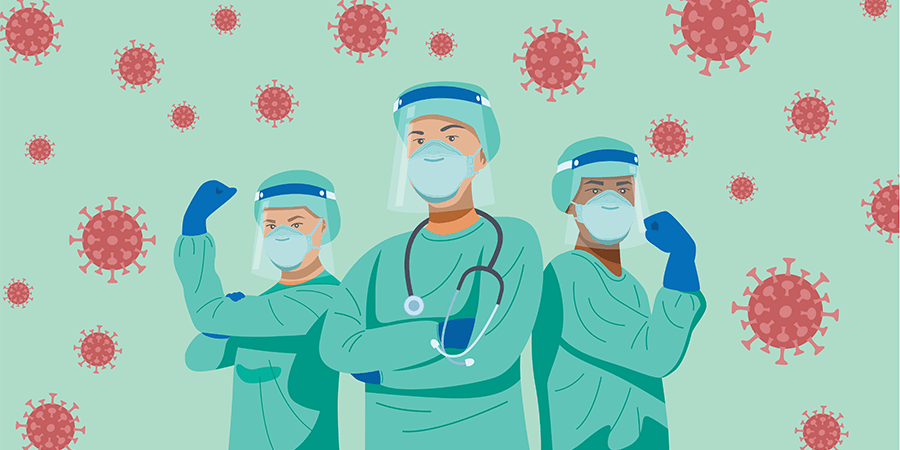It’s not a secret: PPE is important in every healthcare setting. But in the intensity of a hospital setting, amidst staffing shortages and sky-high hospitalization rates, proper PPE protocols might not always be followed. While trying to save lives and stay afloat in the overwhelm, healthcare workers might slip up. They theoretically know and understand PPE is important, but it can, unfortunately, be the last thing on their minds in the moment.
It falls to leadership and educators to effectively educate and reinforce proper PPE protocols. But in a world of overworked healthcare workers, what are the best practices for educating them on the use of PPE?
How To Educate Healthcare Workers About PPE
The CDC recommends following the PRECEDE model for educating healthcare workers about PPE best practices. According to RHIhub, “The PRECEDE-PROCEED model is a comprehensive structure for assessing health needs for designing, implementing, and evaluating health promotion and other public health programs to meet those needs. PRECEDE provides the structure for planning a targeted and focused public health program… PRECEDE stands for Predisposing, Reinforcing, and Enabling Constructs in Educational Diagnosis and Evaluation.” In this case, the population that needs promotion and education are healthcare workers.
Dr. Lona Mody, MD, MSc, in conjunction with Linda R. Greene, RN, MPS, CIC and Karen Jones, RN, MPH, worked with the CDC to outline how this applies to healthcare worker education surrounding PPE.
They recommend starting with identifying predisposing aspects, such as knowledge, practices, opinions, and attitudes about the use of PPE. Next, you should note and address enabling factors when developing education. This includes educational in-services about PPE, as well as how PPE fits into the hospital’s or department’s overarching infection prevention strategy. Are there PPE promotion campaigns? Is PPE consistently available at the point of care?
The next step of the PRECEDE model is to address reinforcing factors. You should provide frequent feedback to your healthcare workers and providers surrounding the rate of PPE use.
Engaging leadership can make all the difference, as well. “Top down culture” means that leadership determines the culture of a business, or, in this case, a hospital or unit. If you have the buy-in, support, and investment of the leadership, it will be easier to reinforce protocols and standards. If your leadership team is unenthusiastic about PPE, that will translate downward.
Lastly, you should evaluate the outcomes. As you address the enabling factors, you should reassess the knowledge of and adherence to the PPE protocols. Monitoring infection trends, such as multidrug resistant organisms (MDROs) or hospital acquired infections (HAIs), can also be helpful.
The Benefits Of Frequent Education
Take a minute to try to recall something you learned in the last seminar you went to. Odds are there are a few stand out items you can definitely recall, but what about the details? The nitty gritty of what you learned? As that seminar slips farther and farther into the past, those details become ever more blurry. It’s not that they weren’t important, it’s that our brains are physically incapable of remembering them – especially as time is put between you and the details you are trying to remember.
This is normal – and it’s called the forgetting curve.
In 1885, German psychologist Hermann Ebbinghaus set out to determine why we often struggled to remember things over time. He did this by conducting a number of tests on how own memory over periods of time. He would memorize meaningless words, like “dok” or “ehd”. After a certain amount of time had passed, he would test himself to see how much of the information he retained.
What he found was alarming: after 7 days, you could forget up to 90% of the information you took in. Nowadays, we can see the massive ramifications this has on things like training.
Now, you might be thinking, “But healthcare workers use PPE constantly, so they are always being reminded of PPE protocols.” While it is true healthcare workers use PPE almost daily, this can also be a detriment. It becomes muscle memory – and not a conscious act of best practices.
Thus, training frequency is critical, but so is offering engaging training. You can do this through regular hands on training, also remembering to explain why PPE is so important. But you can also conduct daily reminder style training about the proper use of PPE.
Dr. Mody recommends having frequent conversations versus lectures, including the reference to recent outbreaks. For example, at the time of publication, we are just finishing RSV season for most of the United States. This is a highly infectious disease that poses a large risk to both infants and elderly. At the end of 2022, hospitalizations increased from previous years’ seasonal outbreaks. Thus, the importance of PPE in the hospitals becomes even more important.
Dr. Mody goes on to suggest having unit champions or competitions, judged based on correctly following PPE protocols, including proper use. A friendly competition is a great way to daily reinforce PPE best practices in a unit.
Staying Up To Date On PPE Best Practices
If there is one thing we understand, it’s how to stay clean. LWS has been setting clean air standards in cleanrooms for over 40 years, and now we’ve extended our expertise into the medical field by offering PPE. We’re also proud to have consolidated our knowledge into a comprehensive Knowledge Center, where we offer free resources on industry standards, best practices, and all things sterility and clean air.
We’re excited to be offering more and more resources surrounding sterility and best practices in the medical field. If you want to stay up to date, all you have to do is create a free account.


